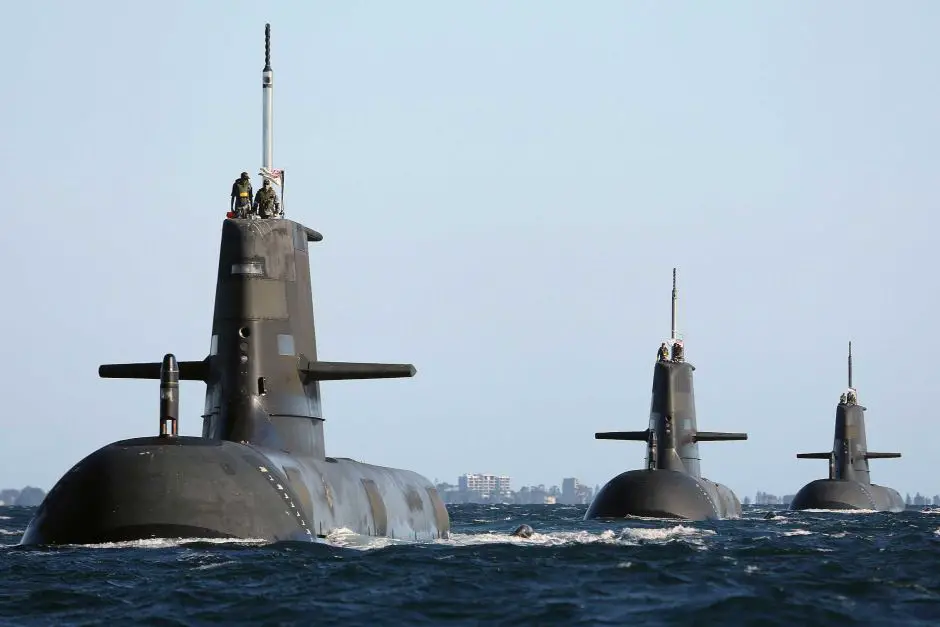The Royal Australian Navy Collins Class submarines will undergo significant upgrades to its sonar systems here in Australia through a multi-million dollar contract with Thales Australia. The upgrades will not only enhance the capability of the Collins Class fleet but will provide a boost to Australian Defence industry and support Australian jobs. The two contracts, worth around $23.7 million, are for the design and implementation of the Mine and Obstacle Avoidance System and the High Frequency Intercept Array for the submarine fleet. The purpose of a Mine and Obstacle Avoidance System is to acoustically detect obstacles, including mines, which pose a threat to the submarine. The High Frequency Intercept Array detects high frequency noises including sonar transmissions.
Minister for Defence, Senator the Hon Linda Reynolds CSC said “Both the Mine and Obstacle Avoidance System and High Frequency Intercept Array are important parts of the upgrades to the Collins sonar system. Our six Collins Class submarines are a highly capable and regionally superior capability that are only halfway through their operational life. To ensure this capability maintains its edge, we are upgrading and improving its systems including through sonar upgrades. With more than 20 years of investment in Australia by Thales and Defence, these upgrades will complement broader improvements to the sonar capability of the Collins Class, ensuring the regional superiority of the fleet into the future.Because of this Government’s action, we have a Collins Class submarine that is now exceeding the Royal Australian Navy’s availability requirement.
Minister for Defence Industry Melissa Price said “Thales had extensive experience working on the Collins fleet and other Australian-based companies would be engaged throughout the contracts. These contracts will include about 80 per cent of work being completed by Australian industry. We can expect these contracts to support 30 new jobs with Thales Australia in Rydalmere, NSW and additional jobs along the supply chain – jobs that will continue throughout the contracts. Once again, we are backing Aussie businesses and creating jobs in our defence industry, which is in turn helping the national economy on its road to recovery after COVID-19.”

The Collins class of six Australian-built diesel-electric submarines is operated by the Royal Australian Navy (RAN). Planning for a new design to replace the RAN’s Oberon-class submarines began in the late 1970s and early 1980s. The Collins class takes its name from Australian Vice Admiral John Augustine Collins; all six submarines are named after significant RAN personnel who distinguished themselves in action during World War II. The boats were the first submarines to be constructed in Australia, prompting widespread improvements in Australian industry and delivering a sovereign (Australian controlled) sustainment/maintenance capability. The submarines, enlarged versions of Swedish shipbuilder Kockums’ Västergötland class and originally referred to as the Type 471, were constructed between 1990 and 2003 in South Australia by the Australian Submarine Corporation (ASC).
The sustainment, maintenance and upgrade of the submarines is undertaken by the platform system integrator, ASC Pty Ltd, in conjunction with the Australian Submarine Enterprise, made up of the Department of Defence, Raytheon Australia (combat system integrator) and the Royal Australian Navy. ASC is also responsible for supply chain management, carries out in-service rectification tasks and is also the design authority for the submarines, with the ability to assess and action changes to the platform design. Under the RAN’s revised usage-upkeep cycle each submarine spends ten years on operations and two years in deep maintenance at ASC’s facility in Osborne, South Australia. The submarines originally had a predicted operational life of around 30 years, with Collins to decommission around 2025.
The submarines have been the subject of many incidents and technical problems since the design phase. Only three could be manned, on average two or fewer were fully operational. The Collins class was expected to be retired about 2026, however, the 2016 Defence White Paper extended this into the 2030s. The Collins class life will now be extended and will receive an unplanned capability upgrade, including sonar and communications. The Collins class will be replaced by the Attack-class submarine that is scheduled, according to the 2016 Defence White Paper, to begin entering service in the early 2030s with construction extending to 2050. The Future Submarine Program will be based on the Shortfin Barracuda, a conventionally-powered variant of a nuclear attack submarine designed by French company DCNS; twelve submarines will be acquired, all built in Australia.














